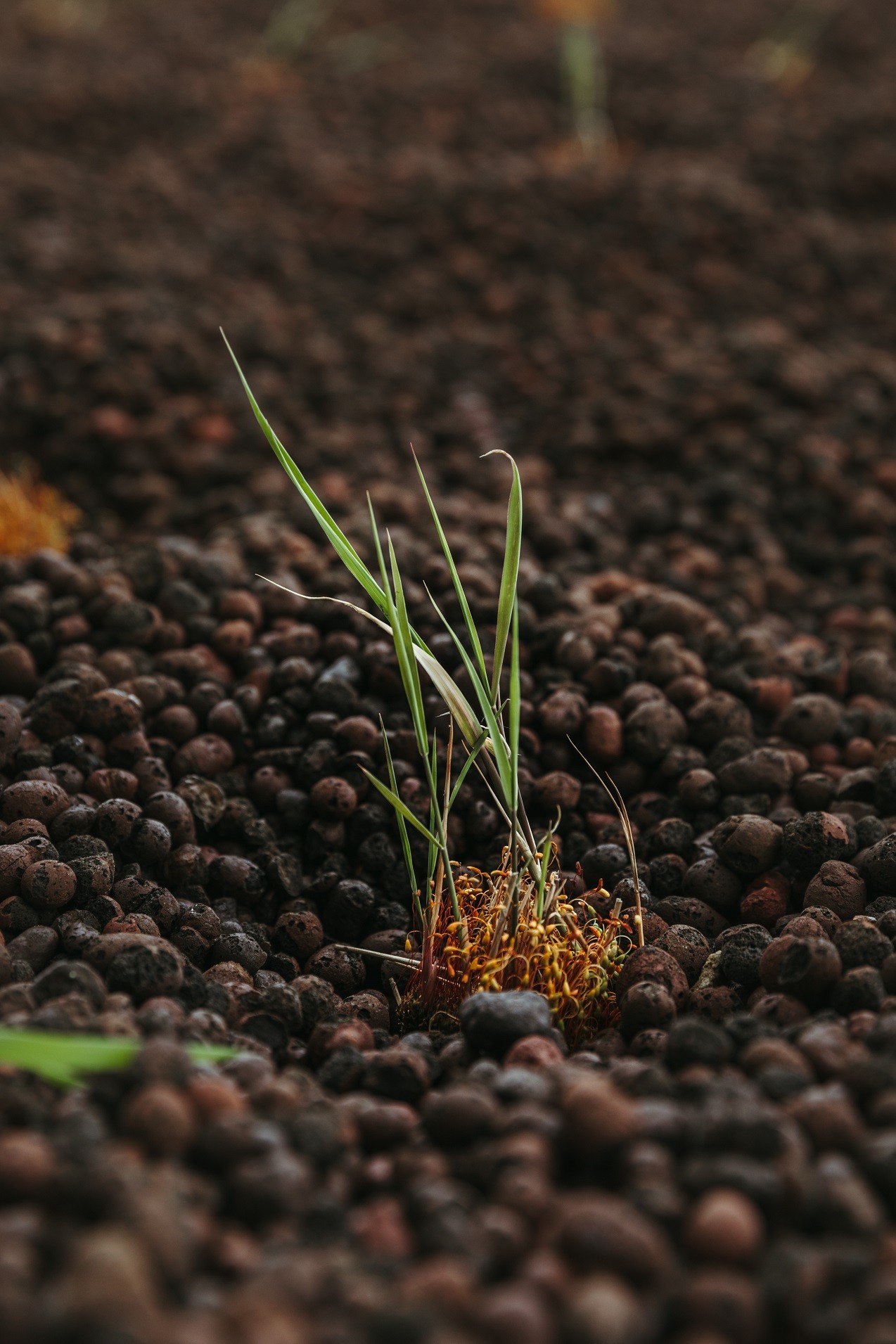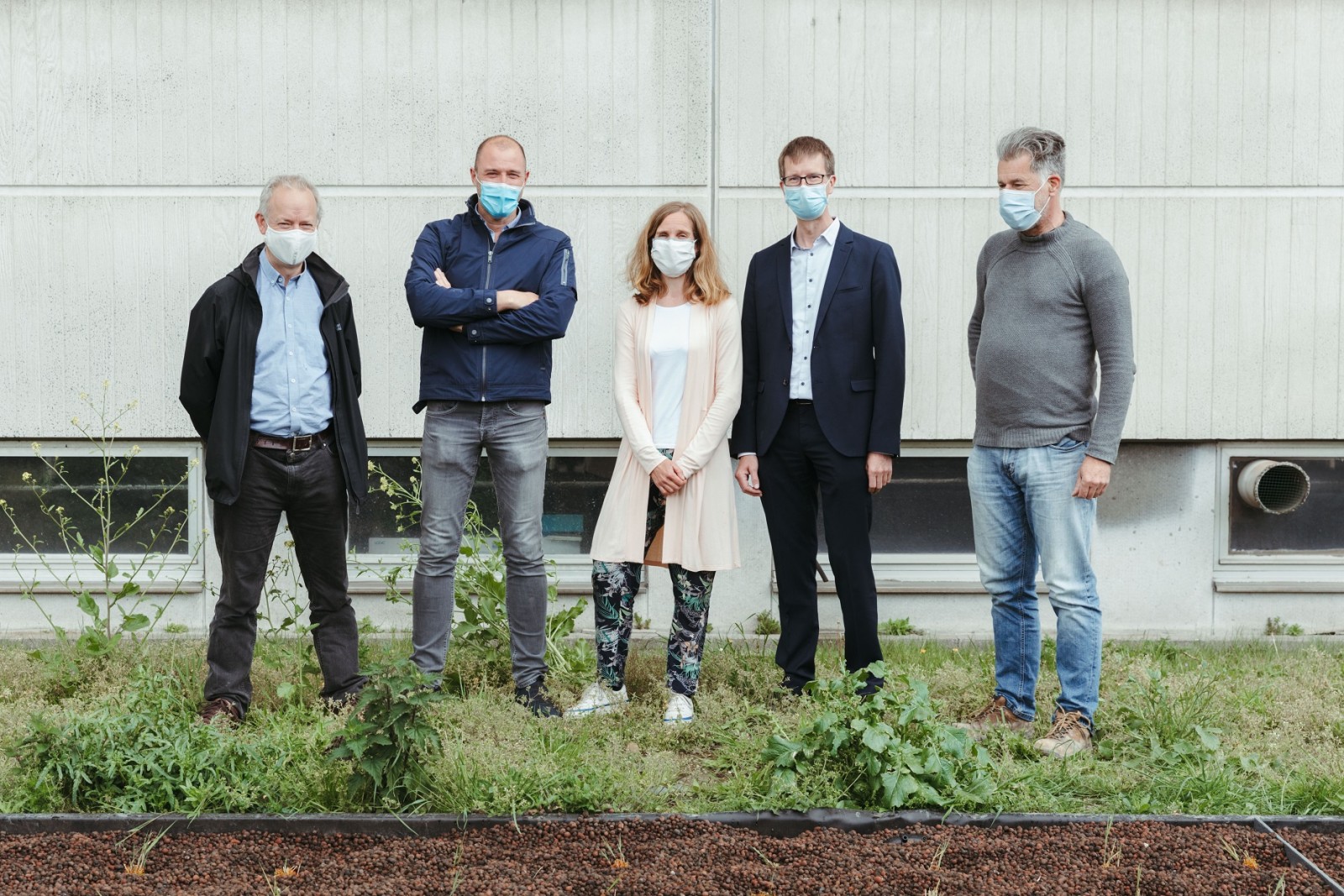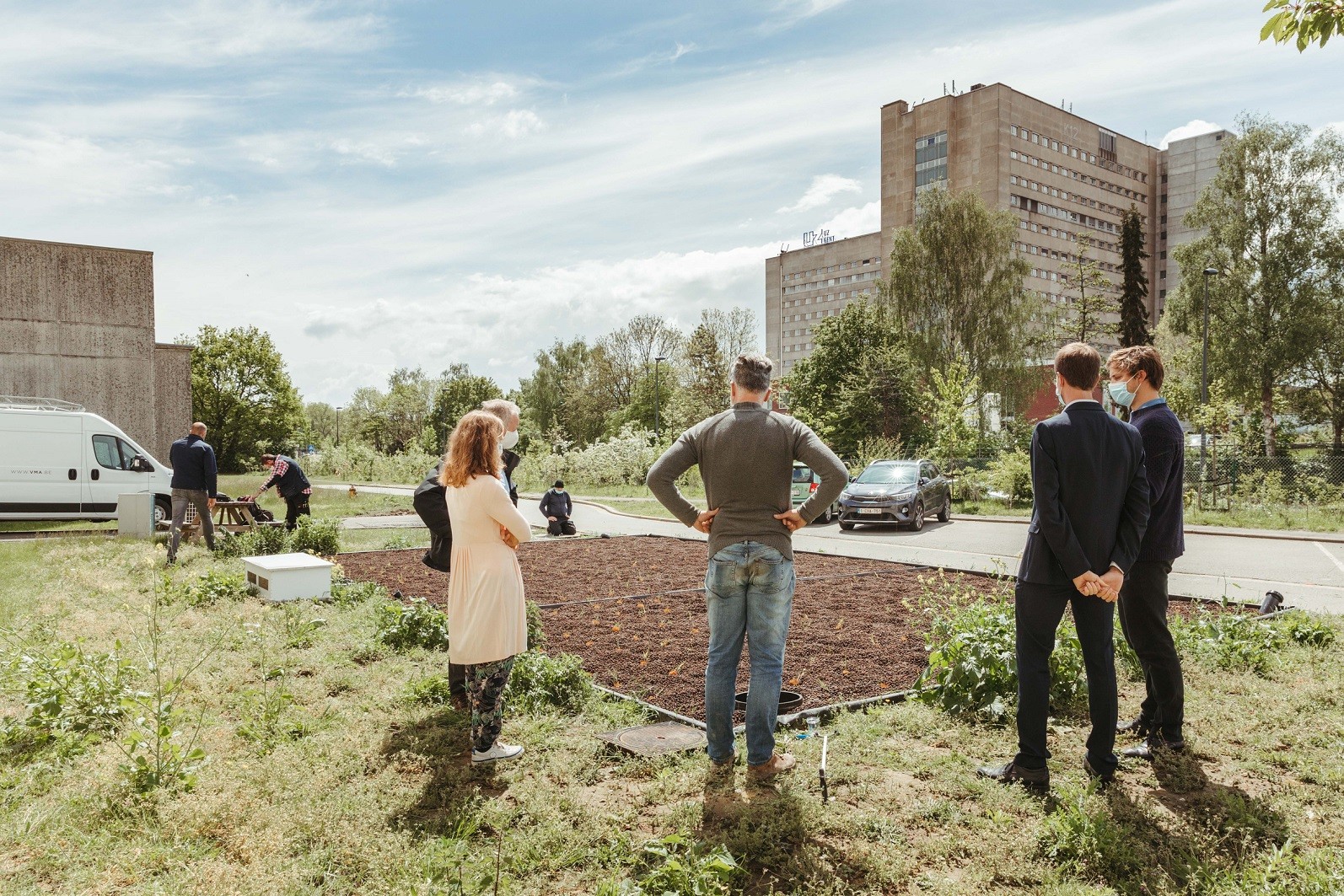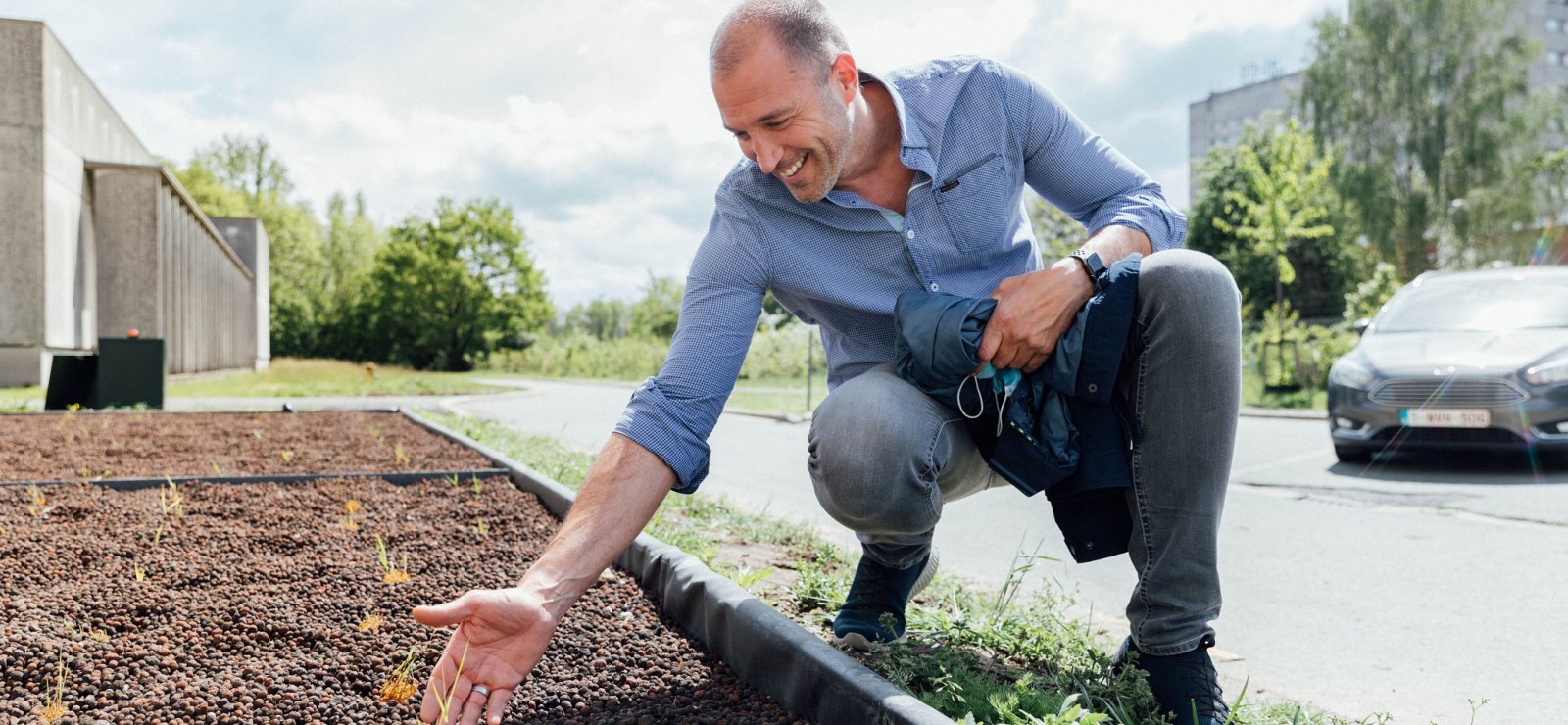Ghent University uses about 260.000 m³ water annually, of which 92% is high-quality tap water. This needs to change. Ghent University is going to instigate the necessary adjustments based on a new policy on circular water management – and a break-away from traditional techniques. This is why, since 12 May, there’s a wastewater treatment facility at Site Heymans in Ghent, Belgium based on water plants and bacteria: a constructed wetland.
The wetland itself lays parallel to the rear of the Faculty of Pharmaceutical Sciences in Ghent, a cement façade that looks out over the roundabout on the busy Heymanslaan. It’s a nondescript field of about 15 by 8 meters full of dark green clay granules, the kind you find in your grandmother’s potted plants. There are little tufts of unfurling plants sticking out of the granules at regular intervals.
Passer-byes would miss it entirely if not for the small, white wooden structure right next to it sprouting a network of PVC-pipes. “Not much to look at, I know,” jokes Greet Persoon of the Ghent University Environment Office, waving a hand at the field. “But this field just might flip the way this institution deals with wastewater on its head.”
Necessary change
Flanders has water problems. Being one of the areas with the highest percentages of impermeable urban surfaces in Europe, the topsoil layer suffers from a lack of water infiltration, which causes the ground water levels to sometimes plummet dangerously low. The heatwaves of the last couple of summers showed how disastrous this can be. Everyone remembers the unceasing drought, the activation of local disaster emergency plans and the reports of desperate farmers.
As Head of the Environment Office at Ghent University, Riet Van de Velde is very aware of the evolution taking place during the last years: “we will have to adjust to the new reality of climate change. The best course of action to help us deal with it is a given: circular water management. This policy looks to implement solutions to close up water cycles locally as much as possible.”

During the last decade, much of the effort has been focussed on rainwater harvesting. Rainwater can be used for applications that don’t require potability, such as toilets, washing machines or animal care. It’s a handy way to save tap water and lowers costs. However, it has become clear that rainwater harvesting by itself isn’t enough and often even has unwanted effects.”
“A large percentage of our water usage goes to flushing toilets,” Tom Ceriez of the Ghent University Department of Infrastructure and Facility Management (DIFM) explains. “We’ve been using rainwater for this as much as possible during the last couple of years. The problem with this, is that the water then needs to be disposed of in the sewer as wastewater, despite there being a need to allow more rainwater to infiltrate into the soil.” Van de Velde agrees because “besides rainwater harvesting, we must also focus on lowering the amount of impermeable areas, better water infiltration into the soil and new, innovative solutions for circular water management.” To this end, she and the Environment Office worked together with DIFM and other specialists at Ghent University to put together a transition plan for circular water management.

from left to right: Vinzens Mausen, Tom Ceriez, Greet Persoon, Diederik Rousseau and Dion Van Oirschot.
An unconventional way of thinking
"The execution of that transition plan required an unconventional way of thinking about problems such as the overdependence on tap water of the Ghent University infrastructure. Those that were working on the plan looked for and found inspiration in the wastewater treatment facility at the Faculty of Veterinary Sciences. Due to the presence of manure in their wastewater, disposal into the sewer system was not allowed. Therefore, the Faculty chose to treat their wastewater on-site. This showed us that on-site treatment and filtration was a viable option,” Ceriez continues while pointing at the wetland with both hands.
Vinzens Mausen of study and design office Hydrio, who helped design the facility at the Faculty of Veterinary Sciences and was also contracted to draw up this pilot project, looks quite pleased as he examines a water sample he just scooped up from between the plants in the field. He explains how the project came about: “Ghent University wanted to start a pilot project for on-site wastewater treatment on two locations, among which here at the Heymanslaan. Simply said, the only criteria they had were that the treatment had to be environmentally friendly and that there would be a high return on investment. It quickly became clear that a constructed wetland was the way to go.”
The design was quickly finished and passed on to Rietland, a specialised company and long-time partner of Ghent University. Its founder Dion Van Oirschot stands next to Mausen and points to two large cement manhole covers laying next to the wetland. “The wastewater that comes from the toilets and labs exits the building there. Before, the wastewater would then flow out of the campus into the sewers. Right now, we have redirected a portion of that water into the constructed wetland. The wetland is filled with helophytes, a group of riparian plants of which the submerged part survives year-round. The bacteria responsible for the actual treatment of the wastewater thrive on the roots of these plants and on the surface of the clay granules that fill the wetland. They process the harmful substances in the wastewater into nutrition and do the actual heavy lifting.”
They are responsible for the actual treatment of the wastewater.”
The treated water then flows back into the campus where it is used for toilet flushing. Due to the limited space we had available here, we chose to employ a system which feeds oxygen into the field mechanically. This increases effectivity tenfold and drastically lowers space requirements.”

Nature-based solutions
The results generated by the constructed wetland will be carefully tracked by prof. Diederik Rousseau of Ghent University Campus Kortrijk, who has been studying environmental sciences and wastewater treatment for more than 20 years. “We will track whether the filtered water here is of sufficient quality and perform system optimization as needed. Our intention is to create a strong use-case which can serve as the basis for future facilities at other Ghent University locations.”
Rousseau has been working with Rietland for a long time and is very enthusiastic about the technology. “The results from other constructed wetlands that Rietland has built in the past speak for themselves. The constructed wetlands are environmentally friendly since they require very little energy and almost no maintenance, while being especially effective at the same time. These natural systems also belong to the so-called ‘nature-based solutions’, meaning that next to wastewater treatment, they also provide other ecosystem services such as urban cooling, air quality improvement and a potential habitat for various species. We see this sort of systems being applied more and more on a global scale.”
“Naturally, we hope that the government will soon realise the potential of these types of systems. Because the problem is that, right now, legislation does not yet allow these types of systems to be rolled out on a larger scale and to be used for other purposes than just flushing the toilet.” He indicates his colleagues Ceriez and Persoon and continues enthusiastically that, despite this, he’s hopeful “because these types of initiatives at Ghent University brings different experts at our institution together, which generates a powerful synergy. Ghent University as a testing ground can pave the way for wide-spread acceptance of new technologies and concepts in the marketplace. This is the only way large-scale change is possible.”
Ghent University policy
Ghent University is going all in on circular water management. Want to find out more about our policy or other projects? Check out our transition plan (in Dutch) for a circular water system, which is part of the climate plan or contact milieu@ugent.be.
Read also
Purifying water helps both companies and the planet move forward
Companies, farmers, nature and consumers alike depend on water. Yet despite the fact that 70% of the Earth’s surface is covered with water, only 1% of it is drinkable. And as climate change progresses, ensuring sufficient water for everyone is becoming increasingly challenging. Advancing water purification technologies is therefore more essential than ever.
Elisa demonstrates how fish waste can become a resource (and wins an award in the process)
In her master’s dissertation, bioengineer Elisa Kooy demonstrated how fish waste could find alternative uses, among others in future generations of rechargeable batteries. Her dissertation landed her the NBN Sustainability Award, which is part of the Flemish Dissertation Award. “The prize is wonderful but the process was even more valuable.”
'Belgian Nobel Prize' for pioneering work by Professor Veronique Van Speybroeck
Professor Veronique Van Speybroeck is one of the world's leading researchers concerning sustainable technologies. For making groundbreaking contributions to the computer modelling of catalysis, she wins the prestigious Francqui Prize for Exact Sciences.
Important step towards sustainable shipping thanks to Ghent University research
At last, a feasible solution for sustainable shipping is on its way. The very first tug running on green methanol, developed by researchers at Ghent University in collaboration with the Anglo Belgian Corporation, is ready to conquer and inspire the maritime world.




